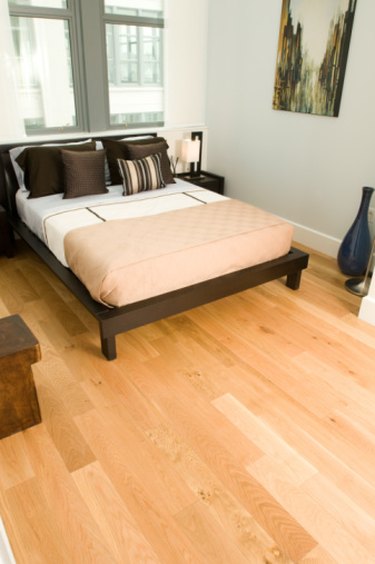
Since the late 19th century, the majority of hardwood flooring boards installed in U.S. homes have been milled with a tongue and groove. By nailing a board through the tongue and tapping the groove of the next board over the nail, the installer is able to securely attach the boards to the sub-floor without the nails being visible. Machines make this job faster, but you can do it by hand as early installers did.
Nailing Hardwood Flooring Boards
Video of the Day
There are two methods for nailing hardwood flooring boards to the sub-floor. The first, face-nailing, is the method you use to secure the first and last course of flooring, as well as boards with straight edges. To face-nail a board, you simply drive a nail through its face into the sub-floor. The second method, called toe-nailing or blind-nailing, involves driving the nails through the tongues of the flooring boards at an angle. The nails secure the boards to the floor, wedging them together at the same time. They also disappear as the grooves of subsequent boards in the installation fit over the nailed tongues.
Video of the Day
Flooring Nailers
Installers toe-nail the bulk of the boards in a floor. Doing it by hand is time-consuming and hard on the knees, so most installers use a machine called a flooring nailer or an air-powered nail gun. The flooring nailer is a pneumatic or air-assisted tool with a plunger that drives a nail at the correct angle when you hit it with a heavy mallet. An experienced installer can drive each nail with a single stroke of the mallet without bending down, and the nails are barbed to resist backing out. An air gun is even more effortless to use, but it doesn't drive barbed nails.
Nailing by Hand
Before the invention of flooring nailers and air guns, installers hand-nailed hardwood floors, and it is still the only way to install boards close to a wall because you need a foot or more of space to use automated nailing tools. Hand-nailing can be laborious. You usually have to drill a pilot hole through the tongue to avoid cracking it with the nail; and as you drive the nail, you must often manually pry the boards together and hold them so they don't separate. After driving the nail almost all the way, you have to sink the head with a nail punch.
Considerations
While it is possible to hand-nail hardwood boards, it isn't advisable for three reasons. The first is that it is much more time-consuming. The second is that the boards won't wedge together as tightly as they do if you use a nailer or air gun, and the finished floor may show gaps between the boards. The third reason concerns the type of nails you can use. The barbed nails that a flooring nailer drives are much more secure than the nails you can drive by hand, which can back out over time and cause sponginess and squeaks.